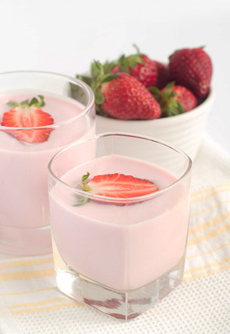

Enjoy either a tall glass of kefir, or “shots,” as shown above. Photo © Viktorija |Fotolia.
|
KAREN HOCHMAN is Editorial Director of THE NIBBLE.
|
|
May 2010
Last Updated March 2014
|
 |
Evolve Kefir Probiotic Smoothie
Page 2: How To Make Kefir? Start With Kefir Grains!
This is Page 2 of a three-page article about kefir and Evolve’s probiotic kefir smoothie line. Click on the black links below to visit other pages .
Making Kefir
Shepherds in the Caucasus Mountains discovered that fresh milk carried in their traditional goatskin drinking pouches would occasionally ferment into a refreshing, effervescent beverage. They learned to control the fermentation using “kefir grains,” a colony of bacteria and yeasts. (Legend has it that the grains were given to the people by the Muslim prophet Mohammed, which gives them the sobriquet “grains of the Prophet.”)
Added to cow’s, goat’s or sheep’s milk, the grains fermented the milk over a period of several days. (The modern fermentation process takes about 24 hours at room temperature, which is much shorter than other cultured products such as yogurt. The grains were not “created,” per se: The grains are self-propagating. As the culture ferments the milk, it grows, creating new grains in the process.
The resulting cultured-milk beverage was creamy and refreshing, with an attractive yogurt-like tartness. Today’s kefir, fermented overnight, has the consistency of drinkable yogurt (although kefir is not yogurt, which is made with specific bacteria and no yeast).
In America, kefir became a healthy base for smoothies. Mass-marketers removed the carbonation and alcohol produced by the fermentation (generally less than 1%) to create a ready-to-drink smoothie in a variety of fruit flavors.
|
|

Kefir grains—the colony of beneficial bacteria and yeast—resemble cauliflower florets. Photo by A Kniesel | Wikimedia. |
There are two types of kefir: water kefir, which are small, transparent grains that ferment sweetened water; and milk kefir, white grains that look rather like cauliflower, that ferment milk.
What’s in the culture? It’s a complex, living colony of more than 30 organisms. Every company has a different “recipe,” but the components can include:
- Probiotic bacteria (examples include lactic acid bacteria, Lactococcus lactis, Streptococcus thermophilus, Lactobacillus delbrueckii bulgaricus, Lactobacillus helveticus, Lactobacillus casei pseudoplantarum and Lactobacillus brevis
- A variety of yeasts (Kluyveromyces, Saccharomyces and Torulopsis, for example)
- Acetic acid bacteria
The Evolve “recipe” is on the next page.
These beneficial microorganisms also help to preserve freshness by holding down the destructive bacteria that cause milk to go bad. They've been shown to inhibit both salmonella and E. coli in laboratory tests.
Continue To Page 3: Flavors Of Evolve Kefir
Go To The Article Index Above
Lifestyle Direct, Inc. All rights reserved. Images are the copyright of their respective owners.

|





